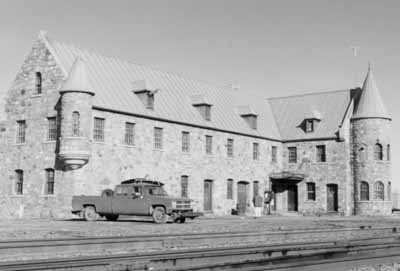Canadian Pacific Railway Station
Heritage Railway Station of Canada
Lacolle, Quebec

Exterior photo
(© Photographie Jacqueline Hallé, 1991.)
Address :
21 Sainte-Marie Street, Lacolle, Quebec
Recognition Statute:
Heritage Railway Stations Protection Act (R.S.C., 1985, c. 52 (4th Supp.))
Designation Date:
1991-11-22
Dates:
-
1930 to 1930
(Construction)
Event, Person, Organization:
-
Charles Reginald Tetley
(Architect)
Research Report Number:
RS-068
Description of Historic Place
The Canadian Pacific Railway (CPR) Station at Lacolle is a two-and-a-half-storey, Chateau-style, railway station, built in 1930. It is located at the eastern edge of the village of Lacolle, near the Canadian-American border. The formal recognition is confined to the railway station building itself.
Heritage Value
Situated close to the Canadian-American border, the Canadian Pacific Railway (CPR) Station at Lacolle played an important and unusual role as both a railway station and a customs and immigration post for Canadian and American officers. Built by the Napierville Junction Railway, a subsidiary of the American-owned Delaware and Hudson Railway, the Lacolle station illustrates the effect of international investment on railway construction in Canada.
The Lacolle railway station is a late example of the Chateau style developed by railway companies during the late-19th and early-20th centuries. Designed by Montreal architect Charles Reginald Tetley, its resemblance to a Normandy manor house reflects the romantic view of its American owners towards the architecture of Old Quebec, and their desire to signify to American travellers that they had arrived in a francophone province.
The station retains its relationship with a stone wall of similar masonry which defines the station property. The station serves as a landmark in the community.
Sources: Heritage Character Statement, Canadian Pacific Station, Lacolle, Quebec, February 1992; and Jacqueline Hallé, Railway Station Report 068, Ancienne gare du Napierville Junction (maintenant Canadien Pacifique), 21 Rue Sainte-Marie, Lacolle, Quebec.
Character-Defining Elements
Character-defining elements of the Canadian Pacific Station at Lacolle include: its Chateau style, evident in the L-shaped plan, steeply pitched roofs pierced by small dormers, gable ends with parapets and kneelers, circular towers with conical roofs and rustic, stone cladding its form and massing, consisting of an L-shaped, two-and-a-half-storey volume, with a circular tower at the end of one wing and a corbelled tower at the corner of the end of the other wing its large size, to accommodate both railway station, and customs and immigration functions its roof line, comprised of two, steeply pitched, intersecting, gable roofs, pierced by small, hip-roofed dormers, and terminated by three gable ends with parapets and kneelers, and separate, steeply pitched conical roofs capping the two towers its masonry, consisting of rustic, stone cladding, rustic stone voussoirs and smooth stone trim used as sills, parapets, kneelers and corbels its use of beaded copper panels as a roofing material its use of local stone as a cladding material, quarried on site the regular arrangement of window and door openings along all elevations segmentally arched door and window openings on the ground floor, round-arched window openings in the towers and attic gable, and rectangular openings on the second storey surviving original window and door units, including wood, sash, multi-light windows and storm windows, wood doors with multi-light uppers, and boarded-up windows in the second storey of the tower which accommodate a signalling apparatus the interior plan of its ground floor, including a waiting room, a ticket office at the intersection of the two wings, the telegrapher’s office in the tower, and a freight room the interior plan of the second floor, consisting of offices surviving original interior finishes and fixtures in the telegrapher’s bay surviving original interior finishes and fixtures in the waiting room, including wood floors, oak panelling and trim, and a coffered ceiling composed of steel joists covered by oak planks.